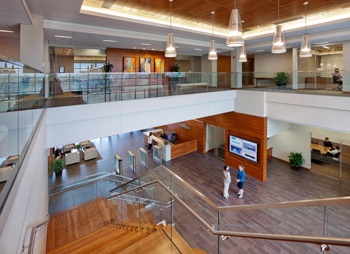Interior Office Design Achieves LEED Platinum
 CAMBRIDGE, Mass. — LEED Platinum certification was not part of the plan for the new 186,000-square-foot Forrester Research headquarters in Cambridge, but it has since achieved that after opening in mid-2011. The project scope included site selection, schematic design of the new building, workspace strategy concept development, complete interior design and construction administration — all of which incorporated green building elements.
CAMBRIDGE, Mass. — LEED Platinum certification was not part of the plan for the new 186,000-square-foot Forrester Research headquarters in Cambridge, but it has since achieved that after opening in mid-2011. The project scope included site selection, schematic design of the new building, workspace strategy concept development, complete interior design and construction administration — all of which incorporated green building elements.
Boston-based Margulies Perruzzi Architects (MPA) was hired as the architect on the project, after designing the global research and advisory firm’s previous 120,000-square-foot headquarters.
“The fact that we did their previous headquarters 10 years earlier gave us an opportunity as designers to revisit a project and learn about how our client had changed over the 10 years and how our new design has to accommodate those changes,” said Janet Morra, AIA, LEED AP, project manager for MPA.
Forrester Research needed more space and hired MPA to help design a new workplace that achieved the company’s environmental standards, as well as reflect the collaborative culture for which the company is known. The company also wanted the new space design to incorporate its personality; specific touches, such as naming the conference rooms after rock ‘n’ roll stars, were important to the client and created what the company calls a “buzz” within the workplace.
The decision was made to move to a build-to-suit location, in which the design team could customize the six-story building to meet the company’s needs. The base building already had a LEED Gold rating, which allowed for MPA to achieve LEED Platinum by incorporating green elements into the interior design of the project.
“In the beginning, we were shooting for LEED Gold with the hope that we could get platinum without them having to bend money for things they didn’t really care about,” Morra said. “We wanted to achieve as high of a rating as possible and still be responsible.”
The collaborative environment was built around an entry atrium that Morra called the “heart of the space.” All client conference rooms face the atrium, which was designed so that employees almost have to walk through it to go anywhere else. Other parts of the office are designed for maximum activity because everyone at the company works in open pods, which are flexible workstations built next to team rooms and other community spaces. There is not a single private office in the company.
Because Forrester Research is international and has to communicate with other offices, an extensive A/V scope and video conferencing facilities were worked into the budget. While this was a requirement for the company, it was also a key component in working toward LEED Platinum because the technologies eliminated the need for travel and reduced the company’s carbon footprint over time.
There were other upfront green building costs that the company and architecture firm realized would payback over time. For instance, LED lighting and daylight harvesting allowed for future energy savings.
Other green elements included the building’s proximity to a major mass transit system so employees could take public transportation to work. A park-like space behind the building added a health and recreation component, as employees could play Frisbee or remain active outdoors on nice days. MPA also spent a lot of time looking for materials that were recycled or recyclable and all manufactured within a 500-mile radius.
This was the first MPA project to achieve LEED Platinum. Despite the perception that LEED Platinum is unattainable and that companies have to have huge amounts of money to achieve it, Morra said that she can work with future clients and show them that it doesn’t need to be expensive.
“What we learned is that you really can attain platinum without going to extremes to be responsible as a corporation. The goal was to not do things that [the company] wouldn’t ordinarily do and see how high of a rating they got,” Morra said. “We would not have been able to do that five years ago, but it’s something we can bring to future clients that think they can’t afford [LEED Platinum]. Even just looking at first construction costs was really not out of line for a corporate headquarters of that size.”
